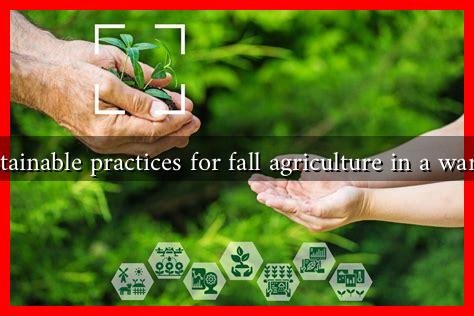-
Table of Contents
- What are Sustainable Practices for Fall Agriculture in a Warming World?
- Understanding the Impact of Climate Change on Agriculture
- Key Sustainable Practices for Fall Agriculture
- 1. Crop Rotation and Diversification
- 2. Cover Cropping
- 3. Conservation Tillage
- 4. Integrated Pest Management (IPM)
- 5. Water Management Strategies
- Case Studies: Successful Implementation of Sustainable Practices
- Conclusion: The Path Forward
What are Sustainable Practices for Fall Agriculture in a Warming World?
As climate change continues to reshape our environment, the agricultural sector faces unprecedented challenges. Farmers must adapt to rising temperatures, shifting precipitation patterns, and increased pest pressures. Sustainable practices in fall agriculture are essential for mitigating these impacts while ensuring food security and environmental health. This article explores effective strategies that farmers can implement to cultivate crops sustainably during the fall season in a warming world.
Understanding the Impact of Climate Change on Agriculture
Climate change has profound effects on agricultural productivity. According to the Intergovernmental Panel on Climate Change (IPCC), global temperatures are projected to rise by 1.5°C to 2°C by the end of the century, significantly affecting crop yields. Key impacts include:
- Increased frequency of extreme weather events, such as droughts and floods.
- Shifts in growing seasons, leading to mismatches between crop cycles and climatic conditions.
- Higher incidence of pests and diseases due to warmer temperatures.
To combat these challenges, farmers must adopt sustainable practices that enhance resilience and productivity.
Key Sustainable Practices for Fall Agriculture
1. Crop Rotation and Diversification
Crop rotation involves alternating the types of crops grown in a particular area across seasons. This practice helps improve soil health, reduce pest populations, and enhance biodiversity. For example, rotating legumes with cereals can fix nitrogen in the soil, reducing the need for synthetic fertilizers.
2. Cover Cropping
Cover crops, such as clover or rye, are planted during the fall to protect and enrich the soil. They prevent erosion, suppress weeds, and improve soil structure. A study by the USDA found that cover cropping can increase soil organic matter by up to 1% per year, significantly enhancing soil fertility.
3. Conservation Tillage
Reducing tillage minimizes soil disturbance, which helps maintain soil structure and moisture. Conservation tillage practices, such as no-till or reduced-till farming, can lead to:
- Improved water retention in the soil.
- Reduced erosion and runoff.
- Enhanced carbon sequestration, helping to mitigate climate change.
4. Integrated Pest Management (IPM)
IPM combines biological, cultural, and chemical practices to manage pests sustainably. By monitoring pest populations and using targeted interventions, farmers can reduce reliance on harmful pesticides. For instance, introducing beneficial insects like ladybugs can naturally control aphid populations.
5. Water Management Strategies
Efficient water management is crucial in a warming world. Techniques such as drip irrigation and rainwater harvesting can help conserve water and ensure crops receive adequate moisture. According to the Food and Agriculture Organization (FAO), drip irrigation can reduce water use by up to 60% compared to traditional methods.
Case Studies: Successful Implementation of Sustainable Practices
Several farms worldwide have successfully adopted sustainable practices to enhance fall agriculture:
- Rodale Institute (USA): This research farm has demonstrated that organic practices, including cover cropping and crop rotation, can lead to higher yields and improved soil health compared to conventional methods.
- Farms in the Netherlands: Many Dutch farmers have implemented precision agriculture techniques, using data analytics to optimize water and nutrient use, resulting in increased efficiency and reduced environmental impact.
Conclusion: The Path Forward
As the world grapples with the realities of climate change, sustainable practices in fall agriculture are not just beneficial—they are essential. By adopting strategies such as crop rotation, cover cropping, conservation tillage, integrated pest management, and efficient water management, farmers can enhance resilience and productivity in a warming world. These practices not only contribute to environmental sustainability but also ensure food security for future generations.
For more information on sustainable agriculture practices, visit the Food and Agriculture Organization website.

